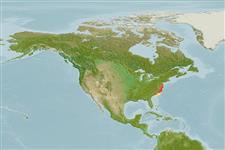Environment: milieu / climate zone / depth range / distribution range
Ökologie
seewasser; süßwasser; brackwasser demersal; amphidrom (Ref. 40808); tiefenbereich 0 - 75 m (Ref. 57178), usually 50 - 60 m (Ref. 51483). Subtropical; 5°C - 22°C (Ref. 13614); 43°N - 9°N, 79°W - 74°W (Ref. 57273)
Western Central Atlantic: Massachusetts to Florida, throughout the Gulf of Mexico, to Panama.
Length at first maturity / Size / Gewicht / Alter
Maturity: Lm ? range ? - ? cm
Max length : 20.0 cm TL Männchen/unbestimmt; (Ref. 7251); common length : 11.0 cm TL Männchen/unbestimmt; (Ref. 12193); max. veröff. Alter: 7 Jahre (Ref. 51483)
Adults inhabit coastal waters. They also enter fresh waters, going hundreds of miles upstream. Migrate downstream to spawn in spring (Ref. 36739). Larvae move upstream after hatching (Ref. 36739). Minimum depth reported taken from Ref. 57178.
Robins, C.R. and G.C. Ray, 1986. A field guide to Atlantic coast fishes of North America. Houghton Mifflin Company, Boston, U.S.A. 354 p. (Ref. 7251)
IUCN Rote Liste Status (Ref. 130435: Version 2024-2)
Bedrohung für Menschen
Harmless
Nutzung durch Menschen
Fischereien: nicht kommerziell
Tools
Zusatzinformationen
Download XML
Internet Quellen
Estimates based on models
Preferred temperature (Ref.
123201): 11.4 - 24.5, mean 17.2 °C (based on 60 cells).
Phylogenetic diversity index (Ref.
82804): PD
50 = 0.5010 [Uniqueness, from 0.5 = low to 2.0 = high].
Bayesian length-weight: a=0.01479 (0.00841 - 0.02600), b=3.03 (2.88 - 3.18), in cm total length, based on LWR estimates for this species & Genus-body shape (Ref.
93245).
Trophic level (Ref.
69278): 3.4 ±0.5 se; based on size and trophs of closest relatives
Generation time: 5.6 ( na - na) years. Estimated as median ln(3)/K based on 1
growth studies.
Widerstandsfähigkeit (Ref.
120179): mittel, Verdopplung der Population dauert 1,4 - 4,4 Jahre. (tm=1; tmax=7; K=0.21(?)).
Fishing Vulnerability (Ref.
59153): Moderate vulnerability (37 of 100).
Nutrients (Ref.
124155): Calcium = 110 [48, 247] mg/100g; Iron = 0.938 [0.463, 1.756] mg/100g; Protein = 18.2 [16.8, 19.5] %; Omega3 = 0.226 [0.110, 0.434] g/100g; Selenium = 19.6 [9.7, 42.5] μg/100g; VitaminA = 16 [5, 56] μg/100g; Zinc = 0.964 [0.630, 1.421] mg/100g (wet weight);
